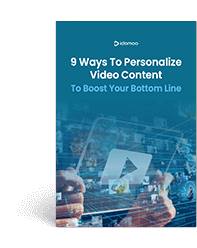What is video content marketing and why is it such a popular part of any digital marketer’s toolbox? And how can you utilise this technology to market your brand and to increase your sales figures?
For starters, social media has become one of the key ways brands market their products, which quickly put video in the spotlight. Video content marketing is starting to play a primary role in companies’ overall marketing strategy, and it’s only increasing as video technology and adoption grows.
In this post, we’ll dig into video content marketing meaning, purpose and process, including practical tips to help you implement an effective video content marketing strategy.
What Is Video Content Marketing?
Simply put, video content marketing is the process of assimilating video content into your digital marketing strategy. Video content can be a short-form video that contains simple but powerful marketing statements, which highlight one or more reasons why consumers should prefer your brand over your competitors, and usually a call to action.
Forbes says videos are successful when they stand out by giving customers a quick overview of a product without overwhelming them with unnecessary text.
And this video-centric view has been adopted by many leaders in tech. Facebook CEO Mark Zuckerberg, for one, has been pushing the “video-first” approach for a while, stating that video will become the main communication tool on Facebook, and that the average Facebook newsfeed will include more videos than images and texts.
10 Video Marketing Tips for a Successful Video Content Marketing Strategy
Now that we have established that a successful marketing strategy should include video content, the next question that needs to be answered is how to build a successful video content marketing strategy. Here are 10 things that you should include in your video marketing strategy.
1. Publishing Schedule
One of the most important aspects of any video content marketing strategy is to follow a publishing schedule. It does not matter how many days a week (or even a month) you post your video content; however, it is crucial that you create a diversified video content marketing plan and a balanced distribution strategy.
2. Multiple Video Channels
There are many different channels for your video content including YouTube, Facebook and Snapchat, and each channel has a different audience and a different end goal.
It is recommended to develop a multi-channel video content marketing strategy to attract users on different devices and during different stages of the marketing funnel.
3. Length of Video
Different video lengths have different aims. Short-form videos are designed to get a quick, powerful message across to your customer base. Longer videos, on the other hand, are designed to provide users with more in-depth content.
Take a topic like escrow analysis, for example, as shown above. That’s a subject your mortgage provider can clearly explain with a video, but it probably deserves more than a 30-second clip.
4. Quality Content
Content is seen as one of the cornerstones of any media marketing strategy. Poor quality content will detract from any marketing effort while creative and high-quality content adds value to your video content marketing strategy.
5. Live Video
Live video streaming is here to stay, and chances are, it deserves a place in your video marketing strategy. Live videos offer a higher level of interaction with viewers, and you can use them to broadcast events in real time or create live Q&A sessions, interactive tutorials and more.
6. Catchy Titles and Opening Scenes
The aim of the video title is to draw the viewer in, and the first seconds of the video will determine whether the viewer will continue watching it or moving on to the next distraction. In other words, with billions of videos available online, people need to be encouraged to stick around to watch your video.
This is one of the reasons we recommend including the viewer’s first name in the opening of the video. It shows them it’s made just for them and increases video completion rates.
See an example with the year-in-review video below.
7. Customer-Generated Content
Asking your customers to send in short videos of their experience with your products or services is a very effective way to market your brands. People are drawn in by videos of other consumers sharing their stories about using your products effectively.
This is actually one of our tips for how to scale video marketing. Read the post for more inspiration.
8. Tips and Tutorials
It’s always a good idea to show people how your products or services work. For example, if you make sports watches, you can shoot a marketing video demonstrating how to use your watch in a simple and appealing way.
If your product is more complicated — say, insurance — you can still use video to onboard customers and help them understand how to take advantage of what they’ve purchased. This is a great first step in a long relationship together.
9. A Call To Action
A call to action invites the viewer to respond to the video content or to engage with your brand. That engagement could be subscribing to your YouTube channel, opting-in to your mailing list or sharing the video with their Facebook friends.
Either way, a CTA is a critical next step that you want viewers to take. This is also an important metric to find out if your video was successful, as you’ll learn below.
10. Performance Measurement
As with all marketing strategies, it’s important to track the engagement and insights of your video marketing campaigns. If they are successful, you continue along the same lines. On the other hand, if they are not successful, you need to make changes to your video marketing strategy.
Final Words on Your Video Content Marketing Strategy
As noted above, video marketing is no longer “nice to have” — it’s essential. All signs are pointing to video content marketing increasing going forward.
We hope you find these tips on how to plan a video content marketing strategy useful. For more information about our Personalised Video platform, please get in touch. We’d love to show you how it works in a demo.
Want More?
Like what you’ve read and want to see more amazing video marketing examples? Check out our video gallery for inspiration.
We’ve also created an infographic about how video is the secret to satisfying the ROI-obsessed client. In the infographic, we pull back the curtain on the effectiveness of video as a communication tool. Click below to download it.





